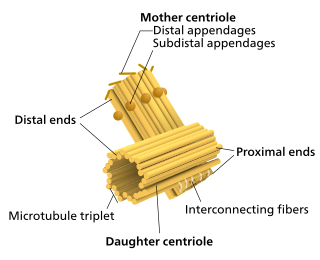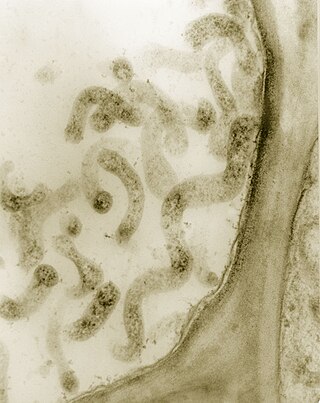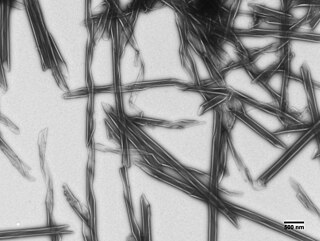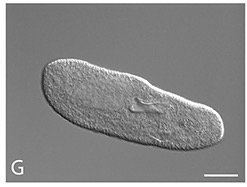Related Research Articles

An endosymbiont or endobiont is any organism that lives within the body or cells of another organism most often, though not always, in a mutualistic relationship. (The term endosymbiosis is from the Greek: ἔνδον endon "within", σύν syn "together" and βίωσις biosis "living".) Examples are nitrogen-fixing bacteria, which live in the root nodules of legumes, single-cell algae inside reef-building corals and bacterial endosymbionts that provide essential nutrients to insects.

Paramecium is a genus of eukaryotic, unicellular ciliates, commonly studied as a model organism of the ciliate group. Paramecium are widespread in freshwater, brackish, and marine environments and are often abundant in stagnant basins and ponds. Because some species are readily cultivated and easily induced to conjugate and divide, they have been widely used in classrooms and laboratories to study biological processes. The usefulness of Paramecium as a model organism has caused one ciliate researcher to characterize it as the "white rat" of the phylum Ciliophora.

Structural inheritance or cortical inheritance is the transmission of an epigenetic trait in a living organism by a self-perpetuating spatial structures. This is in contrast to the transmission of digital information such as is found in DNA sequences, which accounts for the vast majority of known genetic variation.
Tracy Morton Sonneborn was an American biologist. His life's study was ciliated protozoa of the group Paramecium.

Spiroplasma is a genus of Mollicutes, a group of small bacteria without cell walls. Spiroplasma shares the simple metabolism, parasitic lifestyle, fried-egg colony morphology and small genome of other Mollicutes, but has a distinctive helical morphology, unlike Mycoplasma. It has a spiral shape and moves in a corkscrew motion. Many Spiroplasma are found either in the gut or haemolymph of insects where they can act to manipulate host reproduction, or defend the host as endosymbionts. Spiroplasma are also disease-causing agents in the phloem of plants. Spiroplasmas are fastidious organisms, which require a rich culture medium. Typically they grow well at 30 °C, but not at 37 °C. A few species, notably Spiroplasma mirum, grow well at 37 °C, and cause cataracts and neurological damage in suckling mice. The best studied species of spiroplasmas are Spiroplasma poulsonii, a reproductive manipulator and defensive insect symbiont, Spiroplasma citri, the causative agent of citrus stubborn disease, and Spiroplasma kunkelii, the causative agent of corn stunt disease.
Symbiotic bacteria are bacteria living in symbiosis with another organism or each other. For example, rhizobia living in root nodules of legumes provide nitrogen fixing activity for these plants.
Microbial genetics is a subject area within microbiology and genetic engineering. Microbial genetics studies microorganisms for different purposes. The microorganisms that are observed are bacteria, and archaea. Some fungi and protozoa are also subjects used to study in this field. The studies of microorganisms involve studies of genotype and expression system. Genotypes are the inherited compositions of an organism. Genetic Engineering is a field of work and study within microbial genetics. The usage of recombinant DNA technology is a process of this work. The process involves creating recombinant DNA molecules through manipulating a DNA sequence. That DNA created is then in contact with a host organism. Cloning is also an example of genetic engineering.

Gammaproteobacteria is a class of bacteria in the phylum Pseudomonadota. It contains about 250 genera, which makes it the most genus-rich taxon of the Prokaryotes. Several medically, ecologically, and scientifically important groups of bacteria belong to this class. It is composed by all Gram-negative microbes and is the most phylogenetically and physiologically diverse class of Proteobacteria.

In taxonomy, Roseobacter is a genus of the Rhodobacteraceae. The Roseobacter clade falls within the {alpha}-3 subclass of the class Alphaproteobacteria. The first strain descriptions appeared in 1991 which described members Roseobacterlitoralis and Roseobacterdenitrificans, both pink-pigmented bacteriochlorophyll a-producing strains isolated from marine algae. The role members of the Roseobacter lineage play in marine biogeochemical cycles and climate change cannot be overestimated. Roseobacters make up 25% of coastal marine bacteria and members of this lineage process a significant portion of the total carbon in the marine environment. Roseobacter clade plays an important role in global carbon and sulphur cycles. It can also degrade aromatic compounds, uptake trace metal, and form symbiotic relationship. In term of its application, Roseobacter clade produces bioactive compounds, has been used widely in aquaculture and quorum sensing.
Treponema denticola is a Gram-negative, obligate anaerobic, motile and highly proteolytic spirochete bacterium. It is one of four species of oral spirochetes to be reliably cultured, the others being Treponema pectinovorum, Treponema socranskii and Treponema vincentii. T. denticola dwells in a complex and diverse microbial community within the oral cavity and is highly specialized to survive in this environment. T. denticola is associated with the incidence and severity of human periodontal disease. Treponema denticola is one of three bacteria that form the Red Complex, the other two being Porphyromonas gingivalis and Tannerella forsythia. Together they form the major virulent pathogens that cause chronic periodontitis. Having elevated T. denticola levels in the mouth is considered one of the main etiological agents of periodontitis. T. denticola is related to the syphilis-causing obligate human pathogen, Treponema pallidum subsp. pallidum. It has also been isolated from women with bacterial vaginosis.

Bacillus anthracis is a gram-positive and rod-shaped bacterium that causes anthrax, a deadly disease to livestock and, occasionally, to humans. It is the only permanent (obligate) pathogen within the genus Bacillus. Its infection is a type of zoonosis, as it is transmitted from animals to humans. It was discovered by a German physician Robert Koch in 1876, and became the first bacterium to be experimentally shown as a pathogen. The discovery was also the first scientific evidence for the germ theory of diseases.
Microbial toxins are toxins produced by micro-organisms, including bacteria, fungi, protozoa, dinoflagellates, and viruses. Many microbial toxins promote infection and disease by directly damaging host tissues and by disabling the immune system. Endotoxins most commonly refer to the lipopolysaccharide (LPS) or lipooligosaccharide (LOS) that are in the outer plasma membrane of Gram-negative bacteria. The botulinum toxin, which is primarily produced by Clostridium botulinum and less frequently by other Clostridium species, is the most toxic substance known in the world. However, microbial toxins also have important uses in medical science and research. Currently, new methods of detecting bacterial toxins are being developed to better isolate and understand these toxins. Potential applications of toxin research include combating microbial virulence, the development of novel anticancer drugs and other medicines, and the use of toxins as tools in neurobiology and cellular biology.

Paramecium aurelia are unicellular organisms belonging to the genus Paramecium of the phylum Ciliophora. They are covered in cilia which help in movement and feeding.Paramecium can reproduce sexually, asexually, or by the process of endomixis. Paramecium aurelia demonstrate a strong “sex reaction” whereby groups of individuals will cluster together, and emerge in conjugant pairs. This pairing can last up to 12 hours, during which the micronucleus of each organism will be exchanged. In Paramecium aurelia, a cryptic species complex was discovered by observation. Since then, some have tried to decode this complex using genetic data.
Moraxella osloensis is a Gram-negative oxidase-positive, aerobic bacterium within the family Moraxellaceae in the gamma subdivision of the purple bacteria.
Paramecium sonneborni is a species of unicellular organisms belonging to the genus Paramecium of the phylum Ciliophora. It was first isolated in Texas and named after Tracy M. Sonneborn. It is a member of the Paramecium aurelia species complex. They are covered in cilia and are distinguished by their difference in mating patterns and enzyme patterns. The length of Paramecium sonneborni is between 130 and 186 μm with a mean length of 154μm. It is the newest member of the Paramecium aurelia species complex. The current Paramecium sonneborni strains, so far, reveal very low viability in the generations and are a result of allopatric speciation.
Arsenophonus nasoniae is a species of bacterium which was previously isolated from Nasonia vitripennis, a species of parasitoid wasp. These wasps are generalists which afflict the larvae of parasitic carrion flies such as blowflies, houseflies and flesh flies. A. nasoniae belongs to the phylum Pseudomonadota and family Morganellaceae. The genus Arsenophonus, has a close relationship to the Proteus (bacterium) rather than to that of Salmonella and Escherichia. The genus is composed of gammaproteobacterial, secondary-endosymbionts which are gram-negative. Cells are non-flagellated, non-motile, non-spore forming and form long to highly filamentous rods. Cellular division is exhibited through septation. The name 'Arsenophonus nasoniae gen. nov., sp. nov.' was therefore proposed for the discovered bacterium due to its characteristics and its microbial interaction with N. vitripennis. The type strain of A. nasoniae is Strain SKI4.

R bodies are polymeric protein inclusions formed inside the cytoplasm of bacteria. Initially discovered in kappa particles, bacterial endosymbionts of the ciliate Paramecium, R bodies have since been discovered in a variety of taxa.
Vertical transmission of symbionts is the transfer of a microbial symbiont from the parent directly to the offspring. Many metazoan species carry symbiotic bacteria which play a mutualistic, commensal, or parasitic role. A symbiont is acquired by a host via horizontal, vertical, or mixed transmission.

Saccharomyces cerevisiae virus L-A, also called L-A helper virus, is a member of the Totiviridae family of viruses found primarily in Saccharomyces cerevisiae. Its discovery in the 1970s was the main starting point of research on yeast virology. It is a ~4.6 kb double-stranded RNA virus with no extracellular phase and so is inherited through vertical cytoplasmic transmission.

Paramecium biaurelia is a species of unicellular ciliates under the genus Paramecium, and one of the cryptic species of Paramecium aurelia. It is a free-living protist in water bodies and harbours several different bacteria as endosymbionts. Although the bacteria are parasites by definition, they also exhibit mutual relationship with the protist by providing survival benefits. It is used as an organism model in the study of the effects of gravitational forces in different environments.
References
- ↑ Sonneborn, T. M. (1950). "Paramecium in modern biology". BIOS. 21 (1): 31–43.
- ↑ Takayanagi, Tan; Hayashi, Shinji (1964). "Cytological and Cytogenetical Studies on Paramecium polycaryum. V. Lethal Interactions in Certain Stocks". Journal of Eukaryotic Microbiology. 11 (1): 128–132. doi:10.1111/j.1550-7408.1964.tb01733.x. PMID 14119554.
- ↑ Lawrence E. (1999). Henderson's Dictionary of biological terms. London: Longman Group Ltd. ISBN 0-582-22708-9.
- ↑ Rieger R. Michaelis A.; Green M. M. (1976). Glossary of genetics and cytogenetics: Classical and molecular. Heidelberg - New York: Springer-Verlag. ISBN 0-387-07668-9.
- ↑ Brown, C. H. (1950). "Elimination of Kappa Particles from 'Killer' Strains of Paramecium aurelia by Treatment with Chloromycetin". Nature. 166 (4221): 527. Bibcode:1950Natur.166..527B. doi: 10.1038/166527A0 . PMID 14780133.
- ↑ Kappa Particles in mediLexicon
- ↑ Kappa Particles in McGraw-Hill Science & Technology Dictionary
- ↑ Pond, F. R.; Gibson, I.; Lalucat, J.; Quackenbush, R. L. (1989-03-01). "R-body-producing bacteria". Microbiological Reviews. 53 (1): 25–67. doi:10.1128/mr.53.1.25-67.1989. ISSN 0146-0749. PMC 372716 . PMID 2651865.